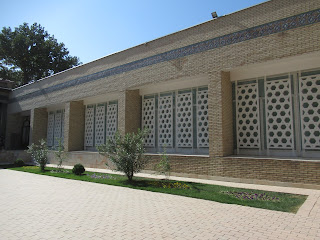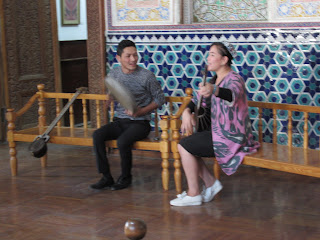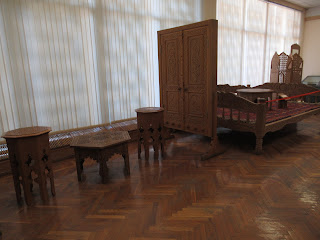Our room at Anvar's Guesthouse in Tashkent was huge but had a few anomalies but we couldn't complain about the price of about $33 a night including a hot breakfast for Steven - I'm not a fan of fried eggs and what looked like hot dogs so Steven had double and I bought yogurt and fruit instead.
Since we'd be coming back to Tashkent in about two weeks, Anvar, the guesthouse owner, kindly let us leave the plaid bag which contained souvenirs we'd bought along the way and a couple of other smaller bags we normally cram in the suitcases. Having a small fridge in the room was useful and the collapsible electrical kettle from home is something I'd never want to travel without again on any long haul trip!
The immense oak tree in the courtyard was planted in the 1880s.
Once we saw the home's exquisite exterior, we knew we were in for a treat inside!
We were greeted by two musicians playing traditional Uzbek instruments and singing in the Central Hall.
Carved wood played a large role in the architectural decor in Uzbekistan as was evidenced by these lovely doors.
These handmade ceramic whistles and other toys were from the last century. We later saw hundreds of ceramic toys just like these for sale in madrassas that doubled as souvenir shops in Khiva, Bukhara and Samarkand. But we have no ‘little ones’ to spoil so didn’t buy any!
I didn't expect to see peacocks out front when I glanced outside!
Uzbekistan is known for its fine ceramics. These were some of the museum's lovely examples. In our two plus weeks in the country, almost all our meals were served on very pretty navy and white china that had gold trim. I would have loved to have bought home a piece that we saw in most cities' markets, but we didn't need it and I was worried about its breaking in our bags.
I learned that art embroidery in gold reached its height in Bukhara in the middle of the 19th century where men performed the task and handed their knowledge down to their sons.
These velvet panels were made with gold and silver embroidery in Bukhara in 1956.
These 20th traditional embroidered skullcaps - called doppi in Uzbek - were made from silk and cotton.
This embroidered textile - called a suzani in Uzbek - was made with cotton and silk threads in 1961 in Tashkent. No bride could get married without a suzani so making one was often a shared task.
The museum, a textile lovers' paradise, was a treasure trove of applied arts of the rich history of Uzbekistan.
For just twelve cents apiece, we hopped on the metro to go back downtown to see the attractive Art Gallery of Uzbekistan which opened in 2004 near Independence Square.
It was odd and sad wandering around the gallery as we saw only two other people the entire time we were there. I was just glad none of the artists were there to see basically no one looking at, and hopefully admiring, their works.
It was helpful having tags naming the artist and the works. Unlike most museums, the tags also listed when the piece was created which I always find helpful as a frame of reference. I found this one, painted in 2001, to be very pleasing. It was called 'A Yard with a Mulberry Tree.'
Bazaar Women was painted in 2008.
'People from All Different Countries Along the Silk Road' was also painted in 2008. I felt like we should have been in that picture since we were also traveling along much of the Silk Road!
This very similar painting from 2009 was titled 'Chorsu Bazaar,' and was named for the huge bazaar we'd just seen north of Tashkent yesterday morning.
This room included paintings by the same artist's Poplar Series. His breadth of work was remarkable in my view.
A quote from Islom Karimov, the aforementioned president:
The bronze cauldron was dated from the 4th century BC.
Having visited the Terracotta Warriors in Xian, China, on our first overseas trip together back in 2013, we immediately recognized the copy of the warrior from 210-209 BC that was a gift from the Chinese government.
'Buddha with Monks' was dated from the 1st to the 3rd century.
Stone stele from the 6th century:
A model of a burial structure from the 6th century:
The calligraphy of this exceptionally large Koran was done in 632.
The protective armor came from the 14th or 15th centuries during Timur's era.
The long decree established a madrassa or religious school.
The map showed the crazy Uzbekistan border drawn up by Joseph Stalin. Later that day, we flew from Tashkent, the capital, depicted in white to the city of Nukus, the yellow section in the far western part of the country. Two days later, we took a lonnng taxi ride to Khiva where we stayed for three nights, then on to Bukhara in the lavender section for another four nights, then another four nights in Samarkand in the green section before returning to Tashkent for one last night.
The top floor had many items extolling the late President Karimov and his political leadership. It was less a museum than shrine and part manifesto for the social and economic development of this part of Central Asia. I would have like to have seen instead more historical info covering the Soviet occupation of Uzbekistan as that was scant.
The History of the People Museum certainly ranked a distant third compared to the other museums we'd seen that day and didn't adequately portray, to me at least, the history of the people. In hindsight, we should have given it a pass.
Since we had almost a couple of hours before we needed to return to the hotel and collect our bags before going to the airport and then fly to Nukus, we found a patch of grass to sit on in a park by the museum and sat and read.
It was the last day for the craft fair we'd been to each of the last couple of days so we walked by there again on the way back to the hotel. Talk about power shopping as I only had about ten minutes but I knew exactly what I wanted having scouted out the booths before!
Since we'd be coming back to Tashkent in about two weeks, Anvar, the guesthouse owner, kindly let us leave the plaid bag which contained souvenirs we'd bought along the way and a couple of other smaller bags we normally cram in the suitcases. Having a small fridge in the room was useful and the collapsible electrical kettle from home is something I'd never want to travel without again on any long haul trip!
Anvar should have named his guesthouse 'House of Mirrors' as there were mirrors everywhere. Plus birds cages!
A couple of blocks from the guesthouse was the Museum of Applied Arts, originally a private house built by a Tsarist diplomat in the 1930s who had been an admirer of Uzbek culture.The immense oak tree in the courtyard was planted in the 1880s.
We were greeted by two musicians playing traditional Uzbek instruments and singing in the Central Hall.
Details of the cornices:
The stunning alabaster decorations on the walls was called ghanch.
I had never seen pale, pastel paintings as we did in the adjoining Drawing Room. After the richness of the entry hall, I found these quite bland.
These ceramics from the 2nd to the 12th centuries were found from Tashkent archaeological expeditions. Later ceramists started to decorate dishes with glazes.
The decorative
terracotta goose was created in Samarkand in 1975.
These handmade ceramic whistles and other toys were from the last century. We later saw hundreds of ceramic toys just like these for sale in madrassas that doubled as souvenir shops in Khiva, Bukhara and Samarkand. But we have no ‘little ones’ to spoil so didn’t buy any!
I didn't expect to see peacocks out front when I glanced outside!
Uzbekistan is known for its fine ceramics. These were some of the museum's lovely examples. In our two plus weeks in the country, almost all our meals were served on very pretty navy and white china that had gold trim. I would have loved to have bought home a piece that we saw in most cities' markets, but we didn't need it and I was worried about its breaking in our bags.
These were some of the 'Seven Beauties' collection of painted porcelain plates done in 1973.
I confess to being so ignorant about Uzbekistan before doing some research prior to our trip to this country and others in Central Asia. One of the things I learned was about the nation's rich history in carpet making as I had naively thought the 'best' carpets only came from Persia, i.e. Iran. Having visited the excellent Carpet Museum in Baku, Azerbaijan, I had a deeper appreciation for stunning 'Oriental' rugs. The designs of these Uzbek rugs were so attractive.
The detailed table and stools were from 1950 in Tashkent. Imagine sitting on such a lovely stool!
The papier-mache and lacquer boxes were made in the 1980s.
One room was dedicated to exquisitely carved wood items made mostly from walnut, elm and mulberry trees. A display noted that, at times, carved wood was the only element used for decorative purposes. These velvet panels were made with gold and silver embroidery in Bukhara in 1956.
These 20th traditional embroidered skullcaps - called doppi in Uzbek - were made from silk and cotton.
This embroidered textile - called a suzani in Uzbek - was made with cotton and silk threads in 1961 in Tashkent. No bride could get married without a suzani so making one was often a shared task.
The museum, a textile lovers' paradise, was a treasure trove of applied arts of the rich history of Uzbekistan.
For just twelve cents apiece, we hopped on the metro to go back downtown to see the attractive Art Gallery of Uzbekistan which opened in 2004 near Independence Square.
Throughout our time in the capital city, we saw so many references to Islom Karimov, the oft revered first president of Uzbekistan and its predecessor, the Uzbek Soviet Socialist Republic, from 1989 until his death in 2016.
The beautiful two-story gallery had a central circular space around an atrium with a magnificent chandelier above.It was helpful having tags naming the artist and the works. Unlike most museums, the tags also listed when the piece was created which I always find helpful as a frame of reference. I found this one, painted in 2001, to be very pleasing. It was called 'A Yard with a Mulberry Tree.'
The second floor had far more contemporary art, all by just one artist, Ibrohim Valihidjaev.
'People from All Different Countries Along the Silk Road' was also painted in 2008. I felt like we should have been in that picture since we were also traveling along much of the Silk Road!
This very similar painting from 2009 was titled 'Chorsu Bazaar,' and was named for the huge bazaar we'd just seen north of Tashkent yesterday morning.
The works were well hung and well lit which we came to appreciate later after seeing other art museums in Uzbekistan where neither was the case! Strangely enough, we didn't see one guard anywhere in the museum except at the entrance.
I paid special attention to the artist's depiction of 'The Registan' knowing we'd be visiting that huge religious complex in Samarkand in about ten days.This room included paintings by the same artist's Poplar Series. His breadth of work was remarkable in my view.
These were two paintings from the same artist's 'Montenegro Series,' a country we visited and really enjoyed several years ago.
I could hardly believe the same artist, Valihodjaev, also painted portraits. I wanted to show you this oil, done in 2014, called 'Portrait of a Gardener,' to show the black hat virtually all older men throughout Uzbekistan wear. The white design on the border varies from city to city.
We counted ourselves very lucky to have seen the special exhibition of works by the immensely talented Valihodjaev at the Art Gallery of Uzbekistan and hoped other tourists and locals saw it before it was too late.
In for a penny, in for a pound, we figured, as we next saw the Museum of the People of Uzbekistan.
The grand entrance turned out to be about the best thing in the museum in my mind!A quote from Islom Karimov, the aforementioned president:
The bronze cauldron was dated from the 4th century BC.
'Buddha with Monks' was dated from the 1st to the 3rd century.
Stone stele from the 6th century:
A model of a burial structure from the 6th century:
The calligraphy of this exceptionally large Koran was done in 632.
The protective armor came from the 14th or 15th centuries during Timur's era.
This was a model of the spectacular Bibi Khanum Mosque in Samarkand we'd be seeing in about ten days.
The long decree established a madrassa or religious school.
The top floor had many items extolling the late President Karimov and his political leadership. It was less a museum than shrine and part manifesto for the social and economic development of this part of Central Asia. I would have like to have seen instead more historical info covering the Soviet occupation of Uzbekistan as that was scant.
The History of the People Museum certainly ranked a distant third compared to the other museums we'd seen that day and didn't adequately portray, to me at least, the history of the people. In hindsight, we should have given it a pass.
Since we had almost a couple of hours before we needed to return to the hotel and collect our bags before going to the airport and then fly to Nukus, we found a patch of grass to sit on in a park by the museum and sat and read.
It was the last day for the craft fair we'd been to each of the last couple of days so we walked by there again on the way back to the hotel. Talk about power shopping as I only had about ten minutes but I knew exactly what I wanted having scouted out the booths before!
As it turned out, we could have spent even more time relaxing in the park or at the craft fair as our flight to Nukus was delayed for 90 minutes! Unlike at most airports, there was not one announcement OR apology about the plane's delay!
Just minutes before the restaurant at the hotel in Nukus closed at ten, we were so lucky to be served an Uzbek national dish called plov, basically flavored rice, carrots and about a quarter cup of meat on top. Fortunately, it was delicious although, not having had anything to eat for hours, we weren't too discerning!
Next post: Mizdakhan Mausoleum & Savitsky Collection.
Posted on October 15th, 2018, from rainy and chilly Turkistan, Kazakhstan.
























































































What a gorgeous art gallery and what beautiful art viewing awaited you both ! But what a shame that there were so few guests. xo
ReplyDeleteWe felt like honored guests having the gallery all to ourselves but I hope the gallery gets more publicity as it deserves it.
ReplyDelete